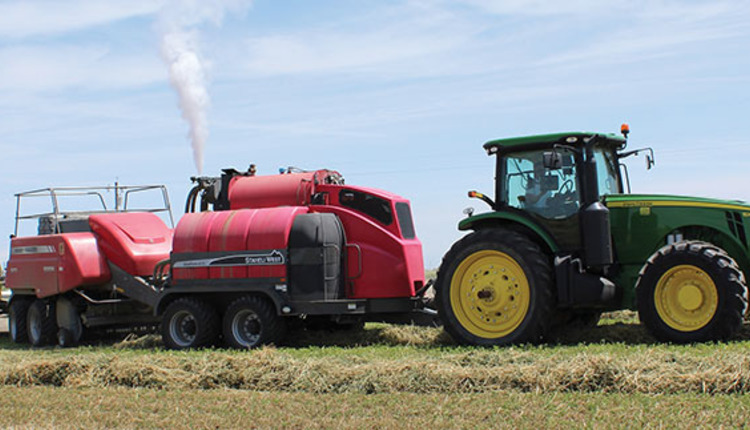They feed more alfalfa leaves |
| By Corey Geiger, Managing Editor, Hoard's Dairyman |
|
|
 Applying steam to alfalfa at the time of baling has been a game changer for Maddox Dairy, Riverdale, Calif. At one time, baling hay was one of the most stressful times of the year for Maddox Dairy. “I don’t think Grandpa ever slept at night during the haying season,” said Steven Maddox, who recalled his grandfather Doug managing four balers at night. That night baling has been routinely necessary for leaf retention in California’s dry Central Valley that relies on irrigation to grow alfalfa. “We needed to capitalize on the night time dew to save the precious high-protein alfalfa leaves,” he said explaining it’s alfalfa’s high protein composition that delivers great value to the herd’s ration. Recently, the Maddoxes switched their way of thinking on harvesting the 2,000 or so acres of alfalfa hay at their dairy. “We now bale hay with a steamer,” says Steven. “If you are looking at our baling activity from the road, it looks like a train . . . or a baler before the baler,” he said. In addition to alfalfa, the Riverdale, Calif., operation double crops an additional 2,000 acres of corn and winter forage for silage or wheat for grain. The Maddox family also grows 2,500 acres of wine grapes along with 1,500 acres that have been diversified into almond trees. “Up close you will notice it’s really not two balers, but a boiler on wheels with a baler following behind,” said Steven, a fourth-generation dairyman and crop farmer. “That boiler generates steam that’s applied to the hay allowing us to bale all day.” “When you count the tractor pulling the baler, the entire system covers about 90 feet,” added Steve Maddox, father to Steven. Mimics dew “From that steamer, we apply water vapor to achieve a consistent 15 percent moisture,” said Steven. “The steam gets applied right before the alfalfa goes into the baler’s pickup head . . . being applied from both the top and the bottom of the windrow. The steam level gets constantly adjusted based on moisture readings measured in the windrow,” he went on to explain. In the process of applying steam, the vaporized water instantly condenses and gets absorbed into the dry crop material. Steam is preferred over liquid water because water vapor more closely mimics dew. “Over the course of 100 acres, we apply roughly 1,000 gallons of water. And the added benefit is that we can bale during the light of day,” he noted. On a dry day, 5 to 7 gallons of water would be added to each ton of hay. This is the third season that the Maddoxes have used the hay steamer setup. Last year, the farm made over 22,000 bales. The unit has water tanks that hold 1,000 gallon of water and a generator to power the low-pressure boiler. It also has four delivery hoses that go under the pickup head, to the wind guard (above the pickup head), the packing chamber, and the packing chamber floor. A 300-gallon diesel tank fuels the hay steaming system. Since making the switch, Riverdale, Calif., dairy farmers have noticed a significant reduction in supplemental protein needs for the milk cow ration. “Our alfalfa hay bales weigh 100 pounds more because we are keeping so many more leaves,” Steven said when describing the farm’s large square bales, which are routinely weighed across the farm’s scale. University studies back up Maddox’s observations as leaf loss generally gets cut in half. As for speed of baling, that generally picks up because more hay is getting packed into each bale. It takes a 170 to 180 horsepower (HP) tractor to pull the entire rig on flat ground. That HP goes up to 200 to 250 when baling on hillier fields. The steamer is commercially produced by Staheli West, which is based out of Cedar City, Utah, in the southwest part of the state. There is one drawback to using the steamer as part of the cropping enterprise. “We cannot use the steamer when temperatures are over 95°F,” said Steven, because the water doesn’t vaporize as well. Better water use With California mired in a drought, the Maddox family also has changed its approach on irrigating alfalfa. “These days we use subsurface drip irrigation to deliver water to alfalfa,” said Steve. “We must conserve our water resources and this is one way to do that.” Previously, the farm used flood irrigation to irrigate alfalfa. Also, growing grapes and almonds, the Maddox family switched to drip irrigation for those crops, too. This article appeared in the August/September 2016 issue of Hay & Forage Grower on page 16. Not a subscriber? Click to get the print magazine. |
